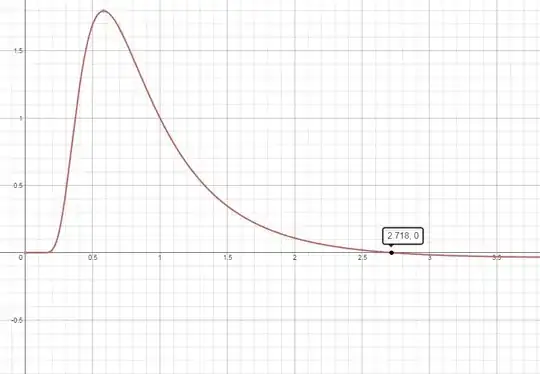An alternative, brute-force way to tackle this problem is basically what Rory did to decide between $2^{1/2}$ and $3^{1/3}$: if you exponentiate all numbers by $7!$, you are sure to get all integer values
$$
\bigl\{k^{\frac{7!}{k}}|k\in\{1\ldots7\}\bigr\}
$$
Unfortunately they're rather big-ish...
GHCi> [ k ^ (product [1..7] `div` k) | k<-[1..7] ]
[1,
394084245522141626953485431836389151728191722497516426553221541823493367658800961065564478638820000356056388337167035542074008945401913950236214360506399705231203021164366069389563701733455174652493802096528279659381259483508916176782516892616322154881870596505654577774329808187256502370468256875376316278135937985788160888518809137837873180086327183792757748702946460720720770436177477377229784500022657580657233628383930137914619684009220791267089768552182903618603146950084219242780072578071648001265726679873751772302343114358428552134991938056446803917216962620267368806273089867659639177213488960155211698149211030681779788578141054359274289556411400436598704927821275214881488970218576557325551889577507340928956338410400961096026352642413831783448576,
3661912215373489067242249621132336961610290182229273707167398710876614002208383109152480213707986686872375122262823321167475157779382448880082398480746724280018352246496425709765006815739802937329118909032303852395641094542256170191689227965576694930360217879714593185250058052659033043099481347841901512973200683071279368653749416285340166533780186704458918301959849893495738166812440825398619614897586259234866683821976521877416906874042851545999400717457006303853919690522754781679747975594958591113536855815138459335042071169602620465754362712624336396931069121231223649220741653756791946172957229074471590534449467409015111938950424658629560623120013261353086157489463854787465723269822306205125946816633592230345910648381608113535470519096069897114291378101952082063097558331741722268578938849601,
394084245522141626953485431836389151728191722497516426553221541823493367658800961065564478638820000356056388337167035542074008945401913950236214360506399705231203021164366069389563701733455174652493802096528279659381259483508916176782516892616322154881870596505654577774329808187256502370468256875376316278135937985788160888518809137837873180086327183792757748702946460720720770436177477377229784500022657580657233628383930137914619684009220791267089768552182903618603146950084219242780072578071648001265726679873751772302343114358428552134991938056446803917216962620267368806273089867659639177213488960155211698149211030681779788578141054359274289556411400436598704927821275214881488970218576557325551889577507340928956338410400961096026352642413831783448576,
364556100977819874605503728407741081881676346238948447117857163982799574599912357208765752772609805609216792941532907275084174813028918904234969069220285451654066666460283261825779326556992902934023629217291059811812700201092161637033272762158365274926054054240010344187292896183070687196100649574391718146941190971541979112502472018926815402055402289908282341091909958440280410415495601978687424035436772000234314385172638320786417824167774294732269493833831511078611247246888604243991272627701581023463256401969428865555514986358611545557986044502104498878068279992795447813951124094440195256012527056812275003403114716680371040088551073162797865548409912591341398846456200999455177225172519683837890625,
443660048414121698116896720273098111694627892639926213574513642183588830573572725097614384624929656854477362433985094367622076844148871486402466997159938815714918720533225246415719206145269164491483440088113473133271721551710902954127241545224711822871932621367309647269511669621366804962147364104873801876330729203153951698533647309818607945451914353715510545802805485379098717028338231926737028464504004503561662293072536103139720605781253399604736172810653048846227697050259155272360027923195409050025343802985259990900000152616977832620707076557885534793432774747114996460757553837938070024879032348656207289216741331217382066876812018333391389720576,
295521314766370598718760957190961267014220876452973493503373916219890905153816181542660448581907991795732056662584461354270150436888850541545604825539840387962452645120966643398014723369507352156668886170865380118289497004228254391234909565641031507543122603146317573251628661017089188403226600800563307928140865181430255011119739367579006409418569088936445603946929350297425000321465327604294142433627464875576685927100371269660301351354927495364059849501985417777493884363882045423030414188505485925921956168425832321649711980887028510830566229638084077726689531555183493538978345530566113309436109434032001]
but looking at the length of the numbers shows the third one to be biggest (because longest).
Of course, you couldn't feasibly calculate these giant powers without a calculator (not without some approximation... but then then better do the original problem directly), however if not 7 was the highest candidate but 4 or 5, it would still be doable (if laborious).
GHCi> [ k ^ (product [1..5] `div` k) | k<-[1..5] ]
[1, 1152921504606846976, 12157665459056928801, 1152921504606846976,
59604644775390625]
Furthermore, you don't really need $n!$, only the least common multiple.
GHCi> [ k ^ (foldr lcm 1 [1..5] `div` k) | k<-[1..5] ]
[1, 1073741824, 3486784401, 1073741824, 244140625]

